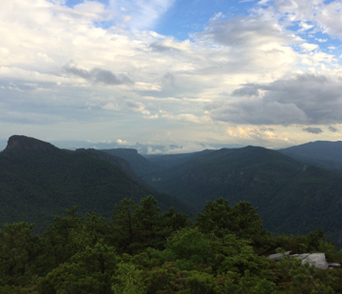 |
Christopher B. Rodning, Ph.D.
Professor
Department of Anthropology
Tulane University
101 Dinwiddie Hall
6823 Saint Charles Avenue
New Orleans, LA 70118 USA
crodning@tulane.edu
http://www.tulane.edu/~crodning/
office 504.862.3051
department office 504.865.5336
department fax 504.865.5338
mobile 504.606.3788
|
|
LINK | for archaeology graduate students
LINK | for undergraduate anthropology majors
|
INTERESTS
archaeology
architecture
culture contact and colonialism
mortuary practices
gender
chiefdoms
southeastern North America
western North Carolina
Southern Appalachians
Gulf South
|
COURSES
Ancient Societies
North American Prehistory
Southeastern U.S. Prehistory
Introduction to Archaeology
Proseminar in Anthropology
Archaeology of Gender
Disasters and Past Societies
Culture Contact and Colonialism
Archaeology of Cultural Landscapes
Roots of Western Civilization
Research Design in Anthropology
Honors Thesis Boot Camp
|
PROJECTS
Lower Mississippi Valley Landscape Archaeology Project
Resilience and Monumentality
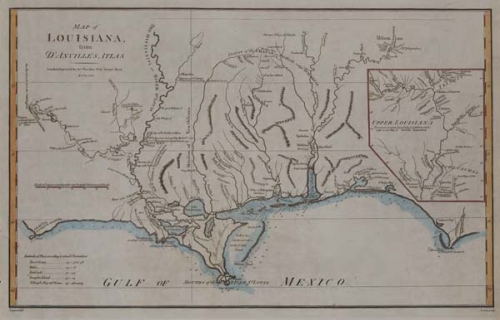
English publication of D'anville's map of La Louisiane, 1788 (http://www.knowla.org/).
Resilience is the capacity of cultural systems to regenerate themselves after catastrophe, crisis, collapse, and disturbance. Given the dynamics of landscapes and waterscapes created by deltaic cycles and changes in sea levels, the changing courses of rivers, and periodic storms, Native American earthworks in the Lower Mississippi Valley and coastal Louisiana represent some of the most durable landmarks in these areas of the Gulf South. Mounds and moundbuilding created persistent monumental places in dynamic environments, and they were sources of cutlural stability and resilience.
|
The Protohistoric Southeast
Entanglement, Ethnogenesis, and Chaos Theory

Native American groups of southeastern North America.
Chaos theory posits that changes in dynamic systems are unpredictable, but not random, and that those changes are highly sensitive to initial conditions. This latter property of chaotic systems is known as the butterfly effect. This perspective offers an interpretive framework for studying the long-term trends and shorter-term events and developments that shaped the emergence of historically known Native American groups in the American South.
|
Exploring Joara
Native American Towns and Early European Contact in the Western North Carolina Piedmont
(with David G. Moore, Ph.D., and Robin A. Beck, Ph.D.)
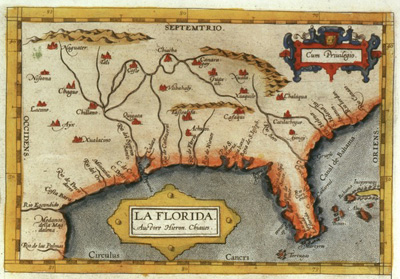
Map of La Florida, by Geronimo Chaves, published by Abraham Ortelius, 1584 (http://dcc.newberry.org/).
During the sixteenth century, Spanish conquistadors and colonists explored and settled the southern Appalachians, and encounters and entanglements between them and Native American groups altered the course of European colonial history and Native American history in the Southeast. Archaeology at the Berry site sheds significant light on this episode of cultural history in the American South. This site, in the upper Catawba Valley of western North Carolina, is the location of the Native American town of Joara (1400-1600) and the Spanish colonial outpost of Cuenca and Fort San Juan (1566-1568).
|
Cherokee Towns
The Cultural Landscape of the Appalachian Summit Province in Southwestern North Carolina
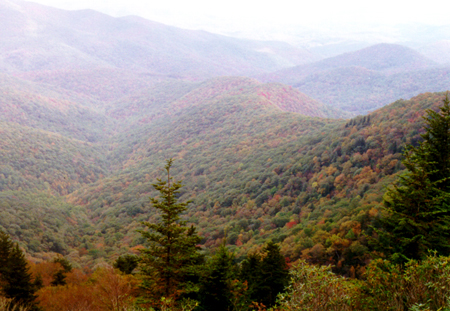
Appalachian Summit landscape in southwestern North Carolina.
The archaeology of earthen mounds, public structures known as townhouses, and other aspects of the built environment of Cherokee towns demonstrate deep connections between places, placemaking, memory, and ethnogenesis in the Cherokee landscape.
|
|
NEWS
2018
- SLA News Archive, April 2018: "Professional Activities, RSA in NOLA, SAA in DC" | PDF | URL
- Panelist, Roundtable, "Representations of Race in the Renaissance," Renaissance Society of America, New Orleans, Louisiana, 22 March 2018
- Panelist, Symposium, "Indigenous Spaces, French Expectations: Exploring Exchanges Between Native and Non-Native Peoples in Louisiana," New Orleans Center for the Gulf South, Tulane University, New Orleans, Louisiana, 14 March 2018
- SLA News Archive, March 2018: "Professional Activities, Chapter in 'Everyday Matters' Volume Published by University Press of Florida" | PDF | URL
- phys.org, "Archaeologist Uncovers Hidden History of Conquistadors in American South," 28 February 2018 | PDF | URL
- Tulane New Wave article (by Mary Cross), "Archaeologist Uncovers Hidden History of Conquistadors in American South," 27 February 2018 | PDF | URL
- "Culturally Grounded Forms of Health Promotion: Subsistence, Health, Well-Being, and Resilience Among American Indians," by Catherine E. Burnette, Carolyn B. Clark, and Christopher B. Rodning, poster presented at the annual Health Sciences Research Days, Tulane University, New Orleans, Louisiana.
- SLA News Archive, February 2018: "Professional Activities, Events at the Society for Historical Archaeology Conference" | PDF | URL
- Mobile First Light Marathon, 3:33:02, 14 January 2018
2017
- December 2017 | Rodning, Christopher B., Jayur M. Mehta, Bryan S. Haley, and David J. Watt (2018) Chaos Theory and the Contact Period in the Southeast. In Investigating the Ordinary: Everyday Matters in Southeast Archaeology, edited by Sarah E. Price and Philip J. Carr, pp. 24-38. University Press of Florida, Gainesville.
- SLA News Archive, December 2017: "Professional Activities, Papers at the Southeastern Archaeological Conference" | PDF | URL
- "Moundbuilding and Bundling in Southeastern North America," by Christopher B. Rodning, paper presented at the annual conference of the American Anthropological Association, Washington, D.C., 30 November 2017
- SLA News Archive, November 2017: "Professional Activities, Lecture for the Traumatology Institute, School of Social Work, Tulane University" | PDF | URL
- "Mississippian Settlement at the Catawba Meadows Site, North Carolina," by Amber R. Thorpe, Hannah G. Hoover, and Christopher B. Rodning, poster presented at the annual meeting of the Southeastern Archaeological Conference, Tulsa, Oklahoma, 10 November 2017
- "'Fifteen Feet High and Unexplored': The Berry Site Mound in North Carolina," by David G. Moore, Robin A. Beck, and Christopher B. Rodning, paper presented at the annual meeting of the Southeastern Archaeological Conference, Tulsa, Oklahoma, 10 November 2017
- "An Archaeology of Cherokee Placemaking in the Southern Appalachians," by Christopher B. Rodning, paper presented at the annual meeting of the Southeastern Archaeological Conference, Tulsa, Oklahoma, 9 November 2017
- SLA News Archive, October 2017: "Professional Activities, Chapter in Religion and Politics in the Ancient Americas" | PDF | URL
- A Studio in the Woods Scholarly Retreat: Archaeology of Monuments (Marcello Canuto, Tatsuya Murakami, Jason Nesbitt, Chris Rodning
- SLA News Archive, September 2017: "Professional Activities, Papers at Conferences at Tulane University and Ole Miss" | PDF | URL
- Class Notes, "Book published by the University Press of Florida...," Harvard Magazine, September-October 2017
- "From the Coast to the Mountains: Marine Shell Artifacts at Cherokee Towns in the
Southern Appalachians," by Christopher B. Rodning, paper presented at the annual Midsouth Archaeological Conference, Center for Archaeological Research, University of Mississippi, Oxford, 30 July 2017
- Mountain Xpress, "Evidence of Spanish Colonists Reshapes Western North Carolina History," 30 June 2017 | PDF | URL
- Morganton News-Herald, "Archaeologists to Open Berry Site for Annual Field Day," 23 June 2017 | PDF | URL
- May 2017 | Rodning, Christopher B., and Jayur M. Mehta (2015) Reconsidering the Sims Site, St. Charles Parish, Louisiana. Louisiana Archaeology 42:3-24.
- May 2017 | Beck, Robin A., Lee A. Newsom, David G. Moore, and Christopher B. Rodning (2017) Spaces of Entanglement: Labor and Construction Practice at Fort San Juan de Joara. Historical Archaeology 51(2):167–193.
- SLA News Archive, May 2017: "Professional Activities, Paper at the Annual Conference of the Society for American Archaeology in Vancouver, 2017" | PDF | URL
- Southeastern Archaeological Conference Newsletter 59 (2017), 2016 Patty Jo Watson Award announcement read at the business meeting of the Southeastern Archaeological Conference (2016), April 2017
- "South Appalachian Mississippian in Western North Carolina: The Pisgah and Qualla Phases," by Christopher B. Rodning and David G. Moore, paper presented at the annual conference of the Society for American Archaeology, Vancouver, British Columbia, 31 March 2017
- SLA News Archive, March 2017: "Professional Activities, Papers at the Upland Archaeology in the East Symposium and Louisiana Archaeological Society, 2017" | PDF | URL
- "Learning More about Fort San Juan and Joara: Continuing Investigations at the Berry Site," by David G. Moore, Christopher B. Rodning, Robin A. Beck, and Abra J. Meriwether, paper presented at Upland Archaeology in the East (Symposium XII), Laboratories of Archaeology, Department of Anthropology, Appalachian State University, Boone, North Carolina, 25 February 2017
- Chris Rodning, "Spanish Conquistadors, Colonists, and Native American Chiefdoms in the American South,", Stigler Lecture Series, Department of Anthropology, College of Arts and Sciences, University of Arkansas, Fayetteville, Arkansas, 17 February 2017
- SLA News Archive, February 2017: "Stigler Lecture, Department of Anthropology, University of Arkansas, 'Spanish Conquistadors, Colonists, and Native American Chiefdoms in the American South'" | PDF | URL
- SLA News Archive, January 2017: "Morris Bart Lecture Series, Jewish Community Center, New Orleans, 'Archaeology of Louisiana Indians'" | PDF | URL
- Archaeological Field School at the Berry Site, Morganton, North Carolina, June 5 - July 1, 2017
![]()
Caption. Image source: Chris Rodning, Tulane University.
2016
SLA News Archive, December 2016: "Annual Meetings of the Southeastern Archaeological Conference and the American Anthropological Association" | PDF | URL
"Reconstructing Elusive Events at Fort San Juan," by Christopher B. Rodning, David G. Moore, and Robin A. Beck, paper presented at the annual conference of the American Anthropological Association, Minneapolis, Minnesota, 20 November 2016
SLA News Archive, November 2016: "Patty Jo Watson Award from the Southeastern Archaeological Conference" | PDF | URL
Tulane University, School of Liberal Arts Newsletter, "Newsletter Cover: Can You Dig It?," October 2016 | PDF | URL
"The Routes and Artifact Assemblages of Sixteenth-Century Spanish Entradas as Seen from Western North Carolina," by David G. Moore, Christopher B. Rodning, Robin A. Beck, and Abra J. Meriwether, paper presented at the annual conference of the Southeastern Archaeological Conference, Athens, Georgia, 27 October 2016
Tulane University, School of Liberal Arts Newsletter, "News from the Field (Chris Rodning): Spanish Conquistadores and Native American Chiefdoms in Western North Carolina," October 2016 | PDF | URL
SLA News Archive, October 2016: "Paul and Debra Gibbons Professor, School of Liberal Arts, Tulane University" | PDF | URL
SLA News Archive, September 2016: "Archaeology of the American South: New Directions and Perspectives," University of Alabama Press, Tuscaloosa | PDF | URL
SLA Summer Programs, Summer 2016: Slide Show.
Warren Wilson College, "History-Changing Archaeology Site Puts Warren Wilson Applied Learning on the Map," by Kyle McCurry, 23 August 2016 | PDF | URL
Morganton News-Herald, "Field Day Educates Public About Archaeological Site," 8 July 2016 | PDF | URL
Morganton News-Herald, "Pictures from the Sixteenth Annual Public Field Day at the Berry Site," 25 June 2016 | PDF | URL
Morganton News-Herald, "Field Day to Educate the Public on Archaeological Site," 23 June 2016 | PDF | URL
SLA News Archive, May 2016: Professional Activities, Coauthored Paper in American Antiquity about Food and Gender Relations at Joara and Fort San Juan, 2016 | PDF | URL
SLA News Archive, May 2016: Professional Activities, Activity at the Annual Conference of the Society for American Archaeology in Lake Buena Vista, 2016 | PDF | URL
Morganton News-Herald, "Exploring Joara Foundation Community Day at Catawba Meadows Park, Morganton, North Carolina," 29 April 2016 | PDF | URL
"The Juan Pardo Expeditions in Northern La Florida," by Christopher B. Rodning, David G. Moore, and Robin A. Beck, paper presented at the conference on Santa Elena and Sixteenth-Century La Florida, South Carolina Institute of Archaeology and Anthropology, Santa Elena Foundation, University of South Carolina, Beaufort, South Carolina, 15 April 2016
"Fort San Juan, Cuenca, and Joara: Spanish Relations with Native Americans in Northern La Florida," by David G. Moore, Christopher B. Rodning, and Robin A. Beck, paper presented at the conference on Santa Elena and Sixteenth-Century La Florida, South Carolina Institute of Archaeology and Anthropology, Santa Elena Foundation, University of South Carolina, Beaufort, South Carolina, 15 April 2016
"Resilience, Hierarchy, and the Native American Cultural Landscapes of the Yazoo Basin and the Mississippi Delta," by Christopher B. Rodning and Jayur M. Mehta, paper presented at the annual conference of the Society for American Archaeology, Orlando, Florida, 7 April 2016
SLA News Archive, April 2016: Professional Activities, Lecture at the University of South Alabama (March), Talks at the Santa Elena Conference in South Carolina (April) | PDF | URL
Morganton News-Herald, "David Moore Speaks to Spanish Embassy and World Bank," 14 March 2016 | PDF | URL
Class Notes, "Book published by the University of Alabama Press...," Harvard Magazine, March-April 2016
Lecture for the Southwest Chapter of the Alabama Archaeology Society and the University of South Alabama Archaeology Museum, Mobile, March 2016: "Joara, Cuenca, and Fort San Juan: Native Americans and Spanish Conquistadors in Western North Carolina, 1540-1568"
March 2016 | Beck, Robin A., Gayle J. Fritz, Heather A. Lapham, David G. Moore, and Christopher B. Rodning (2016) The Politics of Provisioning: Food and Gender at Fort San Juan de Joara, 1566–1568.. American Antiquity 81:3–26.
SLA News Archive, March 2016: Professional Activities, Paper about Native American Settlements and Persistent Places in Mississippi Delta and Southeastern Louisiana Published, 2016 | PDF | URL
New Orleans Rock'n'Roll Marathon, 3:11:35, 28 February 2016
Morganton News-Herald, "Archaeology Day at History Museum of Burke County," 9 February 2016 | PDF | URL
February 2016 | Review of Center Places and Cherokee Towns in American Archaeology
SLA News Archive, February 2016: Professional Activities, Paper in Southeastern Archaeology about Chauga Mound and Village Site Published, 2015 | PDF | URL
January 2016 | Review of Center Places and Cherokee Towns in CHOICE
SLA News Archive, January 2016: Professional Activities, Berry Site Book Published, 2016 | PDF | URL
Fort San Juan and the Limits of Empire: Colonialism and Household Practice at the Berry Site, edited by Robin A. Beck, Christopher B. Rodning, and David G. Moore, University Press of Florida, Gainesville, 2016
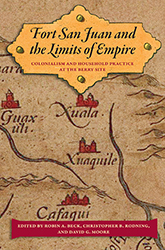 Book cover. Book cover.
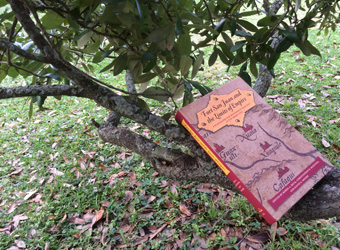 Branch library. Branch library.
Archaeological Field School at the Berry Site, Morganton, North Carolina, June 6 - July 1, 2016
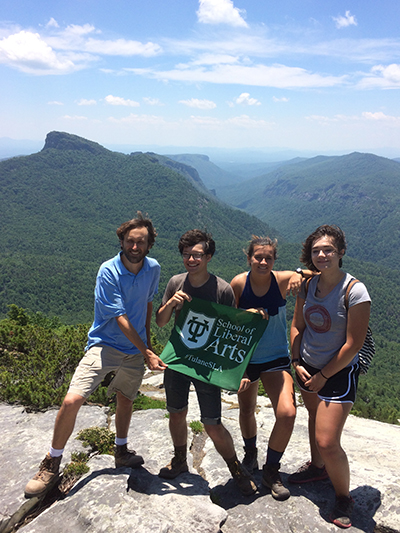
Tulane students hiking near Hawskbill Mountain, Jonas Ridge, Linville Gorge (Hannah Hoover, Tyler Michael, Amber Thorpe) on a day hike on a day off during the Berry site field school. Image source: Chris Rodning, Tulane University.
2015
- December 2015 | Rodning, Christopher B. (2015) Mortuary Patterns and Community History at the Chauga Mound and Village Site, Oconee County, South Carolina. Southeastern Archaeology 34:169-195.
- Letter to the Editor, New Orleans Times-Picayune, nola.com, 12/15/2015, "Archaeological Sites are Nonrenewable Resources" | PDF | URL
- SLA News Archive, December 2015: Professional Activities, Papers at Scholarly Conferences in Las Vegas, Nashville, and Denver | PDF | URL
- 2015 Faculty Showcase Reception, School of Liberal Arts, Tulane University | program (PDF) | snapshots (URL)
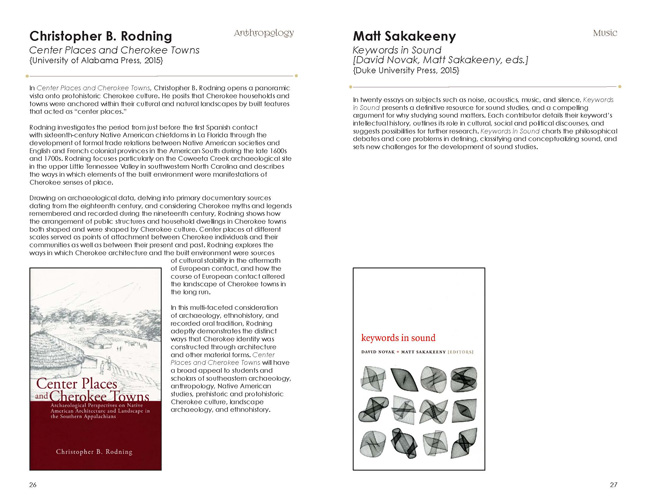 From the program. From the program.
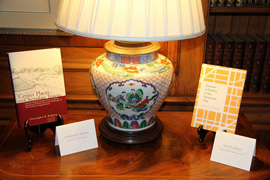 On the table. On the table.
November 2015 | Rodning, Christopher B., and Jayur M. Mehta (2016) Resilience and Persistent Places in the Mississippi River Delta in Louisiana. In Beyond Collapse: Archaeological Perspectives on Resilience, Revitalization, and Transformation in Complex Societies, edited by Ronald K. Faulseit, pp. 342-379. Occasional Report 42, Center for Archaeological Investigations, Southern Illinois University, Carbondale.
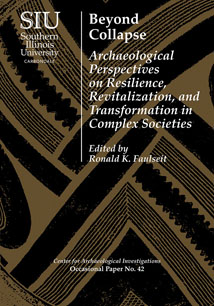 Collapse, revitalization, resilience. Collapse, revitalization, resilience.
"Archaeological Perspectives on Ethnogenesis in Native North America," by Christopher B. Rodning, paper presented at the annual conference of the American Anthropological Association, Denver, Colorado, 21 November 2015
"The Contact Period in the Southeast," by Christopher B. Rodning, Jayur M. Mehta, Bryan S. Haley, and David J. Watt, paper presented at the annual conference of the Southeastern Archaeological Conference, Nashville, Tennessee, 20 November 2015
SLA News Archive, November 2015: Professional Activities, Lecture at the New Orleans Center for the Creative Arts about Native American Settlements and Monuments in Louisiana | PDF | URL
"Spanish Conquistadors and Mississippian Chiefdoms in the Lower Mississippi Valley," by Christopher B. Rodning, Jayur M. Mehta, Bryan S. Haley, and David J. Watt, paper presented at the annual conference of the American Society for Ethnohistory, Las Vegas, Nevada, 10 November 2015
New Orleans Jazz Half Marathon, 1:28:11, 31 October 2015, photos, finish
SLA News Archive, October 2015: Professional Activities, Chapter in Social Archaeology Volume Published by University of Tennessee Press | PDF | URL
SLA News Archive, September 2015: Professional Activities, Center Places and Cherokee Towns Published by University of Alabama Press | PDF | URL
September 2015 | Rodning, Christopher B. (2015) Native American Public Architecture in the Southern Appalachians. In Archaeological Perspectives on the Southern Appalachians: A Multiscalar Approach, edited by Ramie A. Gougeon and Maureen S. Meyers, pp. 105-140. University of Tennessee Press, Knoxville.
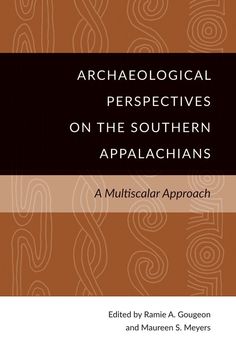 Papers on social archaeology in the Southeast in honor of Professor David Hally. Papers on social archaeology in the Southeast in honor of Professor David Hally.
SLA Reflections (Year in Review), 2014-2015, September 2015: Students from Tulane School of Liberal Arts at Table Rock Mountain | PDF | URL
Center Places and Cherokee Towns: Archaeological Perspectives on Native American Architecture and Landscape in the Southern Appalachians, by Christopher B. Rodning, University of Alabama Press, Tuscaloosa, 2015
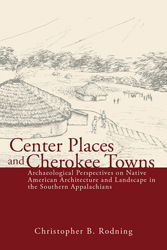 The book cover. The book cover.
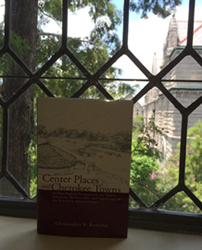 At the window. At the window.
Morganton News-Herald, "Exploring Joara," 26 June 2015 | PDF | URL
Morganton News-Herald, "Uncovered Past," 18 June 2015 | PDF | URL
Archaeology at the Berry Site, Burke Chamber, 30 May 2015 | PDF | URL
Archaeological Field School at the Berry Site, Morganton, North Carolina, June 1 - June 27, 2015
SLA News Archive, May 2015: Professional Activities, Archaeology Conference in April | PDF | URL
"Chiefdoms, Conquistadors, and Colonists in La Florida: Artifacts and Architecture at the Berry Site in Western North Carolina," by Christopher B. Rodning, David G. Moore, and Robin A. Beck, Jr., paper presented at the annual conference of the Society for American Archaeology, San Francisco, California, 19 April 2015
Lecture to the New Orleans Chapter of the Archaeological Institute of America, Loyola University, March 2015: "Fort San Juan: Lost (1568) and Found (2013)"
SLA News Archive, March 2015: Professional Activities, Exploration | JPG | URL
Blue Ridge Country article, "Move Over Jamestown: First Inland U.S. Settlement in NC Mountains?" 23 February 2015 | PDF | URL
"Joara, Cuenca, and Fort San Juan: The Northern Borderlands of La Florida, 1566-1568," by Christopher B. Rodning, Middle American Research Institute, Tulane University, New Orleans, Louisiana, 30 January 2015 | PDF
"Native American Chiefdoms and Spanish Conquistadores in Western North Carolina, 1540-1568," by Christopher B. Rodning, Department of Anthropology colloquium, Tulane University, New Orleans, Louisiana, 23 January 2015 | PDF
Tulane University, School of Liberal Arts Newsletter, "News from the Field (Chris Rodning): Spanish Conquistadores, Fort San Juan, and Native American Towns in Western North Carolina," January 2015
SLA News Archive, January 2015: Professional Activities, Campus Talks in January | PDF | URL
Archaeological Field School at the Berry Site, Morganton, North Carolina, June 1 - June 27, 2015
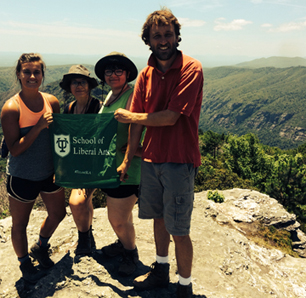
Tulane students on the summit of Table Rock Mountain (Hannah Hoover, Hannah Orr, Amber Thorpe) on a day hike on a day off during the Berry site field school. Image source: Chris Rodning, Tulane University.
2014
- SLA News Archive, Professional Activities, December 2014: American Anthropological Association, 2014 | PDF | URL
- "Community and Communication through Native American Public Architecture in Southeastern North America," by Christopher B. Rodning, paper presented at the annual meeting of the American Anthropological Association, Washington, D.C., 6 December 2014
- SLA News Archive, November 2014, Professional Activities: Southeastern Archaeological Conference, 2014 | PDF | URL
- "Continuing Investigation of the Fort San Juan Moat/Ditch at the Berry Site," by Robin A. Beck, David G. Moore, Sarah C. Sherwood, Christopher B. Rodning, paper presented at the annual meeting of the Southeastern Archaeological Conference, Greenville, South Carolina, 14 November 2014
- "Cherokee Ethnogenesis," by Christopher B. Rodning, paper presented at the annual meeting of the Southeastern Archaeological Conference, Greenville, South Carolina, 13 November 2014
- Exploring Joara Foundation Newsletter: Fall Social and the Annual Meeting, 21 October 2014
- Exploring Joara Foundation Newsletter: Saturday Digs at the Berry Site, 21 October 2014
- Morganton News-Herald, "Exploring Joara Foundation: New Executive Director to Expand Educational Efforts," 12 September 2014 | PDF | URL
- Forthcoming, Center Places and Cherokee Towns, University of Alabama Press, Tuscaloosa, Fall 2014 Catalog: Archaeology/Anthropology/Native American Studies. | URL | PDF
- July 2014 | Rodning, Christopher B. (2014) Cherokee Towns and Calumet Ceremonialism in Eastern North America. American Antiquity 79:425-443.
- Exploring Joara Foundation Newsletter: Volunteer Days at Berry, 26 July 2014
- Exploring Joara Foundation Newsletter: Search for Executive Director, 24 June 2014
- Morganton News-Herald, "Joara Field Day," 23 June 2014 | PDF | URL
- Field Day at the Berry Archaeological Site, Burke Chamber, 19 June 2014 | PDF | URL
- Morganton News-Herald, "Thirteenth Annual Joara Field Day," 17 June 2014 | PDF | URL
- SLA News Archive, June 2014: Society for American Archaeology, 2014 | PDF | URL
- Exploring Joara Foundation Newsletter: Tickets on Sale for the Annual Pottery Festival, 6 May 2014
- "Material Culture at the Northern Edge of La Florida," by Christopher B. Rodning, David G. Moore, and Robin A. Beck, Jr., paper presented at the annual conference of the Society for American Archaeology, Austin, Texas, 26 April 2014
- Exploring Joara Foundation Newsletter: Dedication and Groundbreaking for the Catawba Meadows Archaeological Interpretive Center, 5 April 2014
- Exploring Joara Foundation Newsletter: Archaeology Day at the History Museum of Burke County, 25 January 2014
- National Geographic Society Committee for Research and Exploration grant awarded to Robin A. Beck, Jr., David G. Moore, and Christopher B. Rodning, "Exploring Fort San Juan: Colonial Encounters at the Berry Site, North Carolina," NGS CRE Grant #9490-14, March 2014
- 2014 Berry Site Field School, 6/2/2014 - 6/27/2014 | PDF | URL
- Morganton News-Herald, "EJF Receives $50K Grant (Plans to Hire an Executive Director)," 25 February 2014 | PDF | URL
- Morganton News-Herald, "EJF Hosts Second Artifacts Day at History Museum [of Burke County]," 26 January 2014 | PDF | URL
- New Orleans Rock'n'Roll Marathon, 3:10:43, 2 February 2014, photos, finish
- "Fort San Juan: Lost (1568) and Found (2013)," by Christopher B. Rodning, David G. Moore, and Robin A. Beck, Jr., paper presented at the annual conference of the Society for Historical Archaeology, Quebec, Canada, 9 January 2014
- Archaeological Field School at the Berry Site, Morganton, North Carolina, June 2014
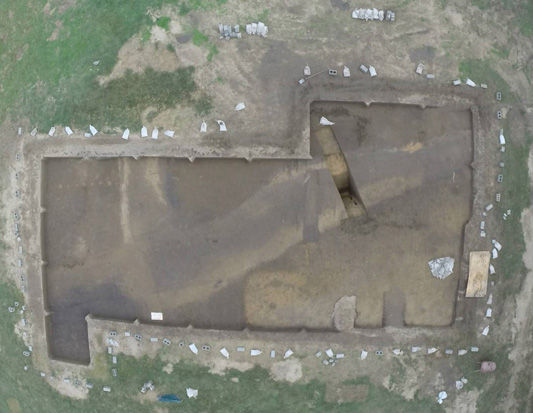
Ditch surrounding Fort San Juan at the Berry site. Image source: Jayur Mehta, Tulane University.
2013
- Discover magazine "Top 100 Stories of 2013," "#29: Lost Spanish Fort Finally Revealed," December 2013 | URL
- Our State magazine article, "History in Your Backyard: Oldest [Inland] European Fort in the U.S. Unearthed," December 2013 | PDF | URL
- Morganton News-Herald, "First Native American Dwelling Complete at Catawba Meadows," 15 December 2013 | PDF | URL
- "An Archaeology Rendezvous in the Lone Star State," by Christopher B. Rodning, SAA Archaeological Record 13(5):7-8, November/December 2013
- "Archaeology, Religion, and European Contact in Native North America," by Christopher B. Rodning, paper presented at the annual meeting of the American Anthropological Association, Chicago, Illinois, 23 November 2013
- "Finding Fort San Juan: New Discoveries at the Berry Site, North Carolina," by Robin A. Beck, Jr., David G. Moore, and Christopher B. Rodning, paper presented at the annual conference of the Southeastern Archaeological Conference, Tampa, Florida, 8 November 2013
- "Late Prehistoric and Protohistoric Pottery in Western North Carolina," by Christopher B. Rodning, paper presented at the annual conference of the Southeastern Archaeological Conference, Tampa, Florida, 7 November 2013
- "'The Mounds and the Constant Fire': The Archaeology of Cherokee Townhouses," paper presented at the annual conference of the Cherokee Archaeology Symposium, Eastern Band of Cherokee Indians, Cherokee, North Carolina, 24-25 October 2013 | PDF | PUB
- "Native Americans and Spanish Conquistadors at the Northern Edge of La Florida," Doris Stone Lecture in New World Archaeology, Archaeological Institute of America, Gainesville Chapter, University of Florida, 10 October 2013 | URL | PDF
- "Spanish Colonialism in the Sixteenth-Century American South," Archaeology Day, National Park Service, Jean Lafitte National Historical Park and Preserve, New Orleans, Louisiana, 5 October 2013 | URL | PDF
- "Native American Mounds in the Mississippi River Delta of Southeastern Louisiana," by Christopher B. Rodning and Jayur M. Mehta, paper presented at the annual conference of the American Society for Ethnohistory, New Orleans, Louisiana, 12 September 2013
- FYI Carolina Online, UNC Office of University Communications, September 2013 | URL
- Science360, NSF Science Now, Episode 15, 17 September 2013 | URL
- “Unearthing the Forgotten Past: Three Carolina Alums Discover the Oldest European Settlement in the Interior U.S.,”
- Carolina Arts and Sciences Magazine
, Fall 2013 | PDF | URL
- "Exploring Joara: Excavating the Past, Shaping the Future in Western N.C.,"
- Carolina Arts and Sciences Magazine
, Fall 2013 | PDF | URL
- Cambridge University Press Blog Post, "Finding Fort San Juan in the Appalachians," written by Rob Beck, 8/20/2013 | PDF | URL
- Cambridge University Press Blog Page, 8/20/2013 | PDF | URL
- Warren Wilson College, "A Major Discovery at the Berry Site," Ben Anderson, 12 August 2013 | PDF | URL
- National Public Radio "Tell Me More" story, "New Discovery Shows Spanish Imprint in U.S.: Inteview with Kenneth Davis," 12 August 2013 | PDF | URL | MP3
- Tulane New Wave inset quote, 8 August 2013 | PDF
- Tulane New Wave front page, 7 August 2013 | PDF
- Tulane New Wave article (by Arthur Nead), "Earliest Inland European Fort [in the United States] Uncovered in North Carolina," 6 August 2013 | PDF | URL
- ABC News Asheville story, "Sixteenth Century Spanish Fort Uncovered Near Morganton," 30 July 2013 | PDF | URL
- Archaeology Southwest headline, "Early Spanish Fort Located in Western, North Carolina" 28 July 2013
- Fox News article, "Medieval Spanish Gold Hunters' Fort Found in North Carolina," 27 July 2013 | PDF | URL
- Bend [Oregon] Bulletin article, "First New World Fort [in the interior U.S. Was Built by Spanish," 26 July 2013 | PDF | URL
- Black Mountain News article, "Rewriting History with Remains of Spanish Fort: Settlement Found in Catawba River Valley," 26 July 2013 | PDF | URL
- Asheville Citizen-Times article, "Rewriting History with Remains of Spanish Fort: Settlement Found in Catawba River Valley," 26 July 2013 | PDF | URL
- WUOM Ann Arbor story, University of Michigan Archaeologist Discovers Sixteenth-Century Spanish Fort," 26 July 2013 | PDF | URL
- WFAE Charlotte broadcast, "Remains of Sixteenth-Century Spanish Fort Found in N.C. Mountains: Interview with David Moore," 26 July 2013 | PDF | URL
- WUNC Chapel Hill broadcast, "Country's Oldest Known [Inland] European Settlement Unearthed in Western North Carolina: Interview with Rob Beck," 25 July 2013 | PDF | URL
- Huffington Post article, "Oldest Fort Built By Europeans In U.S. Interior, Spanish 'San Juan' Garrison, Found In North Carolina," 25 July 2013 | PDF | URL
- Libertad Digital, "Encuentran el Fuerte que Pudo Hacer Españoles los Estados Unidos: Encuentran un Asentamiento Español de 1567 Cuya Destrucción por los Indios Evitó la Expansión de Nuestros Soldados por Norteamérica," 25 July 2013 | PDF | URL
- Morganton News-Herald, " History Unearthed: New Discoveries Confirm Spanish Presence at Berry Site Dig," 25 July 2013 | PDF | URL
- Red Orbit, "European Fort Discovered in the Appalachians," 24 July 2013 | PDF | URL
- CBS News report, "Fort Built by Spanish Conquistadors Discovered in Western North Carolina," 25 July 2013 (from LiveScience) | PDF | URL
- NBC News report, "Fort Built by Gold Hunters Discovered in Western North Carolina," 25 July 2013 (from LiveScience) | PDF | URL
- Yahoo News article, "Spanish Fort Built by Gold Hunters Discovered," 25 July 2013 | PDF | URL
- Colorado Newsday"Oldest European fort in inland USA discovered in Great Smoky Mountains, 450 YEARS after it was destroyed by Native American tribesmen," 24 July 2013 | PDF | URL
- Daily Mail"Oldest European fort in inland USA discovered in Great Smoky Mountains, 450 YEARS after it was destroyed by Native American tribesmen," 24 July 2013 | PDF | URL
- Archaeology Magazine [Online News], "Earliest European Interior Fort Uncovered in North Carolina," 7/24/2013 | PDF | URL
- Business Standard article, "Oldest European Fort in the Inland US Discovered," 24 July 2013 | PDF | URL
- El Mundo article, "San Juan: El Fuerte Perdido de España en Estados Unidos," 24 July 2013 | PDF | URL
- Public Radio International "The World" story, "Long Lost Spanish Fort Discovered in Great Smoky Mountains: Interview with Rob Beck," 24 July 2014 | PDF | URL | MP3
- Past Horizons article, "Oldest Inland Fort Discovered in Appalachians," 24 July 2013 | PDF | URL
- HeritageDaily article, "Oldest European Fort in the Inland US Discovered in Appalachians," 26 July 2013 | PDF | URL
- LiveScience article, "Spanish Fort is Oldest Found in Interior U.S." 24 July 2013 | PDF
| URL
- Raleigh News and Observer article, "New Evidence Supports Location of Spanish Fort Near Morganton," 24 July 2013 | PDF | URL
- Charlotte Observer article, "Spanish Fort Discovered Near Morganton," 24 July 2013 | PDF | URL
- Softpedia, article, "Archaeologists Dig Out the Oldest European Fort in Inland U.S.," 7/24/2013 | PDF | URL
- NBC News Charlotte story, "Sixteenth Century Spanish Fort Uncovered Near Morganton," 24 July 2013 | PDF | URL
- KOAA Colorad Springs Pueblo broadcast, "Archaeologists Discover Europe's Oldest Fort in [the Interior] U.S.," 25 July 2013 | PDF | URL
- Exploring Joara Foundation Newsletter: New York Times Article About Fort San Juan, 23 July 2013 | Newsletter Builder URL | Newsletter Builder PDF | URL PDF
- Archaeology News Report blog, "Oldest European Fort in the Inland U.S. Discovered in Appalachians," 23 July 2013 | PDF | URL
- history.com article, "Archaeologists Discover Oldest Colonial Fort in U.S Interior," 23 July 2013 | PDF | URL
- examiner.com article, "Oldest European Fort in the Inland United States found," 23 July 2013 | PDF | URL
- MountainXpress article, "Oldest European Fort in the Inland U.S. Discovered in Western N.C.," 23 July 2013 | PDF
| URL
- La Voz Arizona article, "Descubren el Fuerte San Juan, El Más Antiguo Fuerte Europeo Dentro de EE.UU.," 23 July 2013 | PDF
| URL
- Vanguardia article, "Hallan el Fuerte Europeo Más Antiguo en EU," 23 July 2013 | PDF
| URL
- Diario Sur article, "Descubren el Fuerte San Juan, El Más Antiguo Fuerte Europeo Dentro de EE.UU.," 23 July 2013 | PDF
| URL
- Terra Mexico article, "Descubren el Fuerte San Juan, El Más Antiguo Fuerte Europeo Dentro de EE.UU.," 23 July 2013 | PDF
| URL
- Terra Argentina article, "Descubren el Fuerte San Juan, El Más Antiguo Fuerte Europeo Dentro de EE.UU.," 23 July 2013 | PDF
| URL
- Terra Chile article, "Descubren el Fuerte San Juan, El Más Antiguo Fuerte Europeo Dentro de EE.UU.," 23 July 2013 | PDF
| URL
- Science Daily article, "Oldest European Fort in the Inland United States Discovered in the Appalachians," 23 July 2013 | PDF | URL
- International Business Times U.S. article, "'Long Lost Fort San Juan' Discovered In Appalachian Mountains, Oldest Inland European Fort Built 40 Years Before Jamestown," 23 July 2013 | PDF | URL
- International Business Times Canada
- International Business Times Australia
- International Business Times U.K. article, "First European Fort in [Inland] United States Discovered in Appalachians," 23 July 2013 | PDF | URL
- phys.org, "Oldest European Fort in the Inland United States Discovered in Appalachians," 23 July 2013 | PDF | URL
- New York Times article, "Fort [San Juan] Tells of Spain's Early Ambition" (updated and corrected version), 23 July 2013 | PDF | URL
- New York Times article, "First New World Fort was Spain's" (original version), 22 July 2013 | PDF | URL
- Morganton News-Herald article about the Exploring Joara Foundation's annual field day at the Berry site
- Blue Ridge National Heritage Area Partnership grant to the Exploring Joara Foundation for archaeology interpretive center at Catawba Meadows Park, Morganton, North Carolina
- Blue Ridge National Heritage Area Newsletter article about Field Day at the Berry Site
- Morganton News-Herald article about the Exploring Joara Foundation's annual pottery festival in Morganton
- Exploring Joara Foundation Newsletter: Annual Field Day at the Berry Site (Saturday, 6/22/2013, 10AM-2PM), Summer Camp Programs, Remembering Charles Hudson (1932-2013), 12 June 2013
- Archaeological Field School at the Berry Site, Morganton, North Carolina, June 3-28, 2013
- May 2013 | Rodning, Christopher B. (2013) Architecture of Aggregation in the Southern Appalachians: Cherokee Townhouses. In From Prehistoric Villages to Cities: Settlement Aggregation and Community Transformation, edited by Jennifer Birch, pp. 179-200. Routledge, London.
- April 2013 | Rodning, Christopher B., Robin A. Beck, Jr., and David G. Moore (2013) Conflict, Violence, and Warfare in La Florida. In Native and Spanish New Worlds: Sixteenth-Century Entradas in the American Southwest and Southeast, edited by Clay Mathers, Jeffrey M. Mitchem, and Charles M. Haecker, pp. 231-247. University of Arizona Press, Tucson.
- March 2013 | Rodning, Christopher B., Jayur M. Mehta, Bryan S. Haley, David M. Chatelain, and Erlend M. Johnson (2013) Revisiting the Lac St. Agnes Site, Avoyelles Parish, Louisiana. Louisiana Archaeology 36:69-94.
- "Resilience, Persistence of Place, and the Native American Settlement at the Sims Site, St. Charles Parish, Louisiana," by Christopher B. Rodning, Jayur M. Mehta, and Bryan S. Haley, Visiting Scholars Conference, Center for Archaeological Investigations, Southern Illinois University, Carbondale, 1 March 2013 (Brochure and Schedule) (Program and Abstracts)
- "Reconsidering the Sims Site, St. Charles Parish, Louisiana," by Christopher B. Rodning, Jayur M. Mehta, and Bryan S. Haley, Louisiana Archaeological Society, Lafayette, 23 February 2013
- "Revisiting the Lac St. Agnes Site, Avoyelles Parish, Louisiana," by Christopher B. Rodning, Jayur M. Mehta, Bryan S. Haley, David M. Chatelain, and Erlend M. Johnson, Louisiana Archaeological Society, Lafayette, 23 February 2013
- "The Berry Site: The First, Lost Colony in North Carolina," David G. Moore, Executive Archaeologist, Exploring Joara Foundation, winner of the Third Annual Excavation Outreach Contest, Archaeological Institute of America, 19 February 2013
- Exploring Joara Foundation Newsletter: Vote for EJF in the AIA Excavation Outreach Contest, 17 February 2013
- Exploring Joara Foundation Newsletter: Entry by EJF in the AIA Excavation Outreach Contest, 14 February 2013
- Archaeological Field School at the Berry Site, Morganton, North Carolina, June 2013
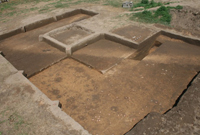
Ditch surrounding Fort San Juan at the Berry site. Image source: Warren Wilson College, 2013.
2012
- Exploring Joara Foundation Newsletter, 27 November 2012
- "Household Archaeology at the Catawba Meadows Site, North Carolina," by Brian S. Geiger, Christopher B. Rodning, Emma R. Richardson, and David G. Moore, Southeastern Archaeological Conference, Baton Rouge, 10 November 2012
- "Spanish Entradas and the Burke Phase," by Christopher B. Rodning, David G. Moore, and Robin A. Beck, Jr., Southeastern Archaeological Conference, Baton Rouge, 9 November 2012
- "Life on the Parenting Track and the Tenure Track," by Christopher B. Rodning, SAA Archaeological Record 12(5):31-32, November/December 2012
- Exploring Joara Foundation Newsletter, 31 October 2012
- Exploring Joara Foundation Newsletter: Annual Meeting | Lecture by George Stuart (National Geographic Society), about the Maya calendar, 27 October 2012
- Exploring Joara Foundation Newsletter: Pat Berry, 19 October 2012
- Exploring Joara Foundation Newsletter: October Events, 8 October 2012
- "Revisiting the Lac St. Agnes Site, Avoyelles Parish, Louisiana," by Christopher B. Rodning, Jayur M. Mehta, Bryan S. Haley, David M. Chatelain, and Erlend M. Johnson, Archaeological Sciences in the Americas Symposium, Vanderbilt University, Nashville, 6 October 2012
- Exploring Joara Foundation Newsletter: John Krebs (Staff Archaeologist), 29 August 2012
- August 2012 | Rodning, Christopher B. (2012) Late Prehistoric and Protohistoric Shell Gorgets from Southwestern North Carolina. Southeastern Archaeology 31:33-56.
- Hickory Daily Record article about annual field day at the Berry site, 24 June 2012
- Morganton News-Herald video about field day at the Berry site, 24 June 2012
- Hickory Daily Record article about installation of historic marker for Fort San Juan at the Berry site by the Colonial Dames Seventeenth Century, 19 June 2012
- Exploring Joara Foundation Newsletter: Annual Field Day at the Berry Site (Saturday, 6/23/2012, 10AM-2PM), 18 June 2012
- Morganton News-Herald video about installation of Fort San Juan historical marker, 18 June 2012
- Morganton News-Herald article about installation of historic marker for Fort San Juan at the Berry site by the Colonial Dames Seventeeth Century, 18 June 2012
- Morganton News-Herald article about groundbreaking ceremony for the Catawba Meadows Interpretive Center, 26 May 2012
- Exploring Joara Foundation Newsletter: Groundbreaking at the Catawba Meadows Interpretive Center, 23 June 2012
- Charlotte Observer article about the Catawba Meadows site and plans for Catawba Meadows Interpretive Center, May 2012
- Exploring Joara Foundation Newsletter: Third Annual Pottery Festival
- Louisiana Board of Regents (BOR) Research Competitiveness Subprogram (RCS) Grant to the Lower Mississippi Valley Landscape Archaeology Project, April 2012
- Archaeological Field School at the Berry Site, Morganton, North Carolina, June 2012
- New Orleans Rock'n'Roll Marathon, 3:12:37, 4 March 2012, photos, finish
- Exploring Joara Foundation Newsletter: Field Trip to Hayesville, Lab Nights, Pottery Festival in May
- "Spanish Visions of the New World," talk by David Moore at the New Voyages to Carolina Conference, East Carolina University, Greenville
- Exploring Joara Foundation Newsletter: Field Trip, Lab Nights, Mars Hill College Talk
- Archaeological Field School at the Berry Site, Morganton, North Carolina, June 2012
2011
- New Orleans Track Club Ole Man River Half Marathon, 1:26:43, 18 December 2011, race, results
- Exploring Joara Foundation Newsletter: Documentary, Conference, Membership, 17 November 2011
- Exploring Joara Foundation Newsletter: Volunteer Day, 7 November 2011
- New Orleans Jazz Half Marathon, 1:25:54, 29 October 2011, photos, finish
- The Birth of a Colony: North Carolina, North Carolina Department of Cultural Resources, documentary broadcast on UNC-TV, 24 October 2011
- The Birth of a Colony: North Carolina, North Carolina Department of Cultural Resources, premiere broadcast on UNC-TV, 19 October 2011
- "Understanding Identity: Archaeological Insights from Colonial and Postcolonial North America and the Caribbean," by Kathryn E. Sampeck, SAA Archaeological Record, 30 September 2011
- Exploring Joara Foundation Newsletter: Volunteer Day, 3 October 2011
- Exploring Joara Foundation Newsletter: Volunteer Day, 4 September 2011
- Exploring Joara Foundation Newsletter: Emma Richardson (Staff Archaeologist), 21 July 2011
- Exploring Joara Foundation Newsletter: Annual Meeting | Lecture by Brett Riggs (Research Laboratories of Archaeology, University of North Carolina, Chapel Hill), about the archaeology of historic Catawba settlements in South Carolina, 21 July 2011
- Exploring Joara Foundation Newsletter: Annual Field Day at the Berry Site (Saturday, 6/25/2011, 10AM-2PM), 20 June 2011
- Morganton News-Herald article about field school at the Berry site, June 2011
- Archaeological Field School at the Berry Site, Morganton, North Carolina, June 2011
- Southeastern Archaeological Conference Resolution, read at the 2010 annual meeting of SEAC and published in the Southeastern Archaeological Conference Newsletter, April 2011
- Exploring Joara Foundation Newsletter: Native American Pottery of the Catawba Valley (exhibit at the Jailhouse Gallery in Morganton), 29 April 2011
- Exploring Joara Foundation Newsletter: Cherokee Pottery Workshop by Tamara Beane (supported by Burke Arts Council Grassroots Grant), 14 April 2011
- Spotted at Tulane University Commencement, Superdome, New Orleans, May 2010
- March 2011 | Rodning, Christopher B. (2011) Cherokee Townhouses: Architectural Adaptation to European Contact in the Southern Appalachians. North American Archaeologist 32:131-190.
- February 2011 | Rodning, Christopher B. (2011) Mortuary Practices, Gender Ideology, and the Cherokee Town at the Coweta Creek Site. Journal of Anthropological Archaeology 30:145-173.
- January 2011 | Beck, Robin A., Jr., Christopher B. Rodning, and David G. Moore (2011) Limiting Resistance: Juan Pardo and the Shrinking of La Florida, 1566-1568. In Enduring Conquests: Rethinking the Archaeology of Resistance to Spanish Colonialism in the Americas, edited by Matthew Liebmann and Melissa S. Murphy, pp. 19-39. School for Advanced Research Press, Santa Fe, New Mexico.
- Exploring Joara Foundation Newsletter, Winter 2011
- Archaeological Field School at the Berry Site, Morganton, North Carolina, June 2011
2010
- December 2010 | Rodning, Christopher B. (2010) European Trade Goods at Cherokee Settlements in Southwestern North Carolina. North Carolina Archaeology 59:1–84.
- "Architecture, Identity, and Cherokee Towns in the Southern Appalachians," by Christopher B. Rodning, paper presented at the annual meeting of the American Anthropological Association, New Orleans, Louisiana, 11 November 2010
- Joara and Fort San Juan: Colonialism and Household Practice at the Berry Site, North Carolina, report to the National Science Foundation, by Rob Beck, David Moore, and Chris Rodning, November 2010
- Morganton News-Herald article about the recent book by Larry Clark about Spanish contact in the Southeast, November 2010
- Symposium, Annual Meeting of the Southeastern Archaeological Conference, organized by Rob Beck, David Moore, and Chris Rodning, October 2010
- Exploring Joara Foundation Newsletter: Sportscar Tour, 23 October 2010
- Morganton News-Herald article about plans for Catawba Meadows Interpretive Center at Catawba Meadows Park, October 2010
- Durham Herald-Sun article about Home School History Hunters fieldwork at the Berry site, September 2010
- North Carolina Piedmont Archaeology Symposium, Research Laboratories of Archaeology, University of North Carolina, Chapel Hill, September 2010
- SLA News Archive: AIA Lecture, September 2010 | PDF | URL
- Exploring Joara Foundation Newsletter: Annual Meeting | Lecture: "The Iceman Cometh," by Edward Hill (Wake Forest University), about the Copper Age mummy found in the Alps in 1991, 21 July 2010
- May 2010 | Rodning, Christopher B. (2010) Place, Landscape, and Environment: Anthropological Archaeology in 2009. American Anthropologist 112:180-190.
- Morganton News-Herald article about excavations at the Berry site, 23 June 2010
- Morganton News-Herald article about the Joara lily by Millstone Meadows Farm, 19 June 2010
- Archaeology Field Day at the Berry Site, Morganton, North Carolina, June 26, 2010, 10:00AM - 2:00PM
- Our State magazine article, "Finding Pardo," June 2010 | PDF | URL
- Morganton News-Herald article about the North Carolina Pottery Festival at Western Piedmont Community College, 20 May 2010
- May 2010 | Rodning, Christopher B., and David G. Moore (2010) South Appalachian Mississippian and Protohistoric Mortuary Practices in Southwestern North Carolina. Southeastern Archaeology 29:80-100.
- May 2010 | Rodning, Christopher B. (2010) Architectural Symbolism and Cherokee Townhouses. Southeastern Archaeology 29:59-79.
- Whodat? They Dat! (Tulane Commencement), Tulanian magazine article, Spring 2010
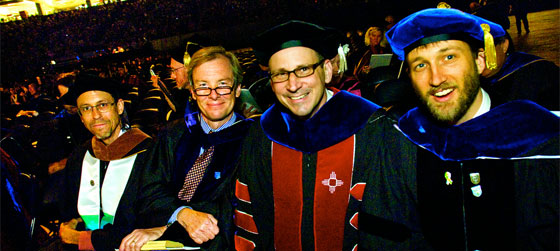 Jeremy Jernegan, Michael Kuczyinski, Trent Holliday, and Chris Rodning at Tulane University Commencement in the New Orleans Superdome. Jeremy Jernegan, Michael Kuczyinski, Trent Holliday, and Chris Rodning at Tulane University Commencement in the New Orleans Superdome.- Exploring Joara Foundation Newsletter: Caroline Ketron (Executive Archaeologist), 11 May 2010
- Tulane University, School of Liberal Arts Newsletter, "News from the Field (Chris Rodning): Spanish Colonial Settlement and Native American Towns in Western North Carolina," May 2010
- David Moore and Colleagues Receive Daughters of the American Revolution Medal, Warren Wilson College Owl and Spade magazine article, Spring 2010
- Asheville Citizen-Times article about DAR award to WWC professor and colleagues, 25 April 2010
- Symposium, Annual Meeting of the Society for American Archaeology, organized by Rob Beck, David Moore, and Chris Rodning, April 2010
- Tulane University, School of Liberal Arts Newsletter, "News and Accolades," April 2010
- National History Medal, given by the North Carolina Chapter of the Daughters of the American Revolution to David Moore, Rob Beck, and Chris Rodning, April 2010
- Exploring Joara Foundation Newsletter: Upcoming Events, April 2010
- SLA News Archive: AIA Lecture, March 2010 | PDF | URL
- Lecture to the South Florida Chapter of the Archaeological Institute of America, Boca Raton, March 2010: "Native American Towns and Spanish Colonists in Western North Carolina, 1540-1568"
- Archaeological Field School at the Berry Site, Morganton, North Carolina, June 2010
2009
- December 2009 | Rodning, Christopher B. (2009) Mounds, Myths, and Cherokee Townhouses in Southwestern North Carolina. American Antiquity 74:627-663.
- Exploring Joara Foundation Newsletter: Upcoming Events, December 2009
- Asheville Citizen-Times article (without pictures) about David Moore and the Berry site, 9 December 2009
- Black Mountain News article (with pictures) about David Moore and the Berry site, 9 December 2009
- PDF version of Archaeological Studies of Gender in the Southeastern United States, edited by Jane M. Eastman and Christopher B. Rodning (University Press of Florida, Gainesville, 2001) now available through the Orange Grove Press and the Florida Digital Repository
- Advanced Seminar on Spanish Contact with Native Peoples of the American Southwest and the Southeast at the Amerind Foundation, Dragoon, Arizona, October 2009 | Group Picture
- North Carolina Mountain Archaeology Symposium, Appalachian State University, Boone, North Carolina, October 2009
- Annual Meeting of the American Society for Ethnohistory, New Orleans, Louisiana, October 2009
- Exploring Joara Project Workshop at the School of Advanced Research, Santa Fe, New Mexico, October 2009 | Group Picture
- Lecture to the New Mexico Chapter of the Archaeological Institute of America, Santa Fe, September 2009: "Native American Towns and Spanish Colonists in Western North Carolina, 1540-1568"
- Morganton News-Herald article about the Wall Center for Archaeological Research, September 2009
- Exploring Joara Foundation Newsletter: Wall Center Dedication, September 2009
- Morganton News-Herald article about Fort San Juan historical marker in Morganton, August 2009
- Exploring Joara Foundation Newsletter: Fort San Juan State Historic Marker Unveiling, [sign photo] [group photo], August 2009
- Exploring Joara Foundation Newsletter: Activity Schedule, Summer 2009
- Asheville Citizen-Times article on archaeology in western North Carolina, June 2009
- Morganton News-Herald article on annual public field day at the Berry site, 28 June 2009
- Annual public field day at the Berry site, 27 June 2009
- WMNC 92.1FM interview (MP3 file, 5:16) about archaeology at the Berry site, 26 June 2009
- Hickory Daily Record article on archaeology at the Berry site, 24 June 2009
- Morganton News-Herald article on the Joara lily, by Millstone Meadows Farm, named for the Native American town at the Berry site, 23 June 2009
- Charlotte Observer article in the Catawba Valley Neighbors section on annual Exploring Joara Foundation public field day at the Berry site near Morganton, June 2009
- Archaeology magazine article on the archaeology of Fort San Juan, the Berry site, and Spanish colonial outposts in western North Carolina, July/August 2009 | PDF abstract | PDF article
- May 2009 | Rodning, Christopher B. (2009) Domestic Houses at Coweeta Creek. Southeastern Archaeology 28:1-26.
- Archaeological Field School at the Berry Site, Morganton, North Carolina, June 2009
2008
- December 2008 | Rodning, Christopher B. (2008) Temporal Variation in Qualla Pottery at Coweeta Creek. North Carolina Archaeology 57:1–49.
- Exploring Joara Foundation Newsletter, Winter 2008
- Historical Marker for Fort San Juan, Burke County, North Carolina, North Carolina Highway Historical Marker Program, North Carolina Department of Cultural Resources, North Carolina Division of Archives and History, Winter 2008
- Community College Times article about field schools at the Berry site, August 2008
- Annual public field day at the Berry site, 12 July 2008
 Archaeological research on Lake James. Archaeological research on Lake James.- American Archaeology article on the Berry site and Fort San Juan, Spring 2008
- Exploring Joara Foundation Newsletter, Spring 2008
- Charlotte Observer article in the Catawba Valley Neighbors section about the Exploring Joara Foundation, March 2008
- Chapel Hill News editorial, February 2008
- Raleigh News and Observer article on the Spanish colony at Fort San Juan, February 2008
- Exploring North Carolina documentary: The First, Lost Colony, episode 405, broadcast on UNC-TV, 31 January 31 2008
- Exploring North Carolina premiere: The First, Lost Colony, at the NC Museum of Natural Sciences, Raleigh, NC, 30 January 2008
- Warren Wilson College News, announcement of Exploring NC documentary and NC Museum premiere, January 2008
- Archaeological Field School at the Berry Site, Morganton, North Carolina, June 2008
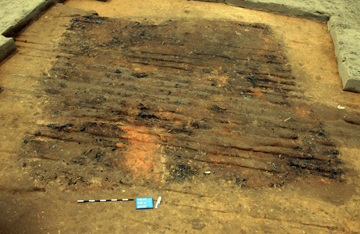
Structure 5 at the Berry site. Image source: Warren Wilson College, 2008.
2007
- Archaeologist Digs Sixteenth-Century America, Tulanian magazine article, Fall 2007 | PDF | URL
- Archaeologist Digs Sixteenth-Century America, Tulane New Wave online article, August 2007 | PDF | URL
- Annual public field day at the Berry site, 14 July 2007
- Charlotte Observer newspaper article on archaeology field day at the Berry site, July 2007
- Charlotte Observer newspaper article on archaeology at the Berry site, June 2007
- NCPedia article, "Fort San Juan," by David Moore, January 2007 | PDF | URL
- Archaeological Field School at the Berry Site, Morganton, North Carolina, June 2007
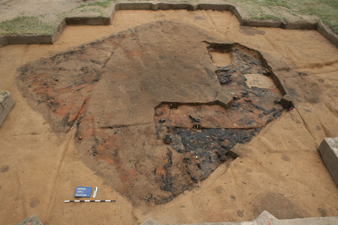
Structure 1 at the Berry site. Image source: Warren Wilson College, 2007.
2006
- BBC History Magazine article "In Search of the Last Conquistadors: Archaeologists Find Spanish Fort Destroyed by Indian Tribes," 12/2006 | PDF | URL
- NSF grant awarded to Robin Beck, David Moore, and Chris Rodning, September 2006
- Smithsonian magazine article on archaeology of Spanish exploration and native towns in western North Carolina, March 2006
- NCPedia article, "Juan Pardo Expeditions," by David Moore, January 2006 | PDF | URL
- May 2006 | Beck, Robin A., David G. Moore, and Christopher B. Rodning (2006) Identifying Fort San Juan: A Sixteenth-Century Spanish Occupation at the Berry Site, North Carolina. Southeastern Archaeology 25:65-77.
- Archaeological Field School at the Berry Site, Morganton, North Carolina, June 2006
2005
2004
2003
- May 2003 | Rodning, Christopher B. (2003) Water Travel and Mississippian Settlement of Mound Island. In Bottle Creek: A Pensacola Culture Site in South Alabama, edited by Ian W. Brown, pp. 194-204. University of Alabama Press, Tuscaloosa.
- Our State magazine article, "Archaeological Excavations in the Catawba River Valley," March 2003 | PDF | URL
- Archaeological Field School at the Berry Site, Morganton, North Carolina, June 2003
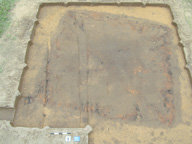
Structure 3 at the Berry site. Image source: Warren Wilson College, 2003.
2002
- May 2002 | Wilson, Gregory D., and Christopher B. Rodning (2002) Boiling, Baking, and Pottery Breaking: A Functional Analysis of Ceramic Vessels from Coweeta Creek. Southeastern Archaeology 21:29-35.
- May 2002 | Rodning, Christopher B. (2002) The Townhouse at Coweeta Creek. Southeastern Archaeology 21:10-20.
- May 2002 | Rodning, Christopher B., and Amber M. VanDerwarker (2002) Revisiting Coweeta Creek: Reconstructing Ancient Cherokee Lifeways in Southwestern North Carolina. Southeastern Archaeology 21:1-9.
- Archaeological Field School at the Berry Site, Morganton, North Carolina, June 2002
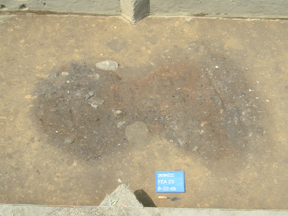
Pit feature between structures 3 and 4 at the Berry site. Image source: Warren Wilson College, 2002.
2001
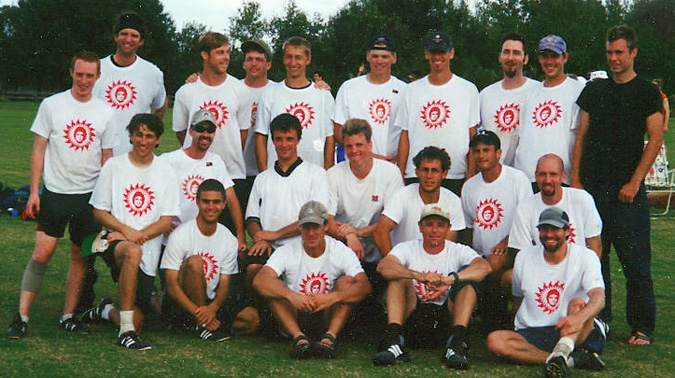
Ring of Fire, Sarasota, Florida.- October 2001 | Rodning, Christopher B. (2001) Architecture and Landscape in Late Prehistoric and Protohistoric Western North Carolina. In Archaeology of the Appalachian Highlands, edited by Lynne P. Sullivan and Susan C. Prezzano, pp. 238–249. University of Tennessee Press, Knoxville.
- September 2001 | Sullivan, Lynne P., and Christopher B. Rodning (2001) Gender, Tradition, and the Negotiation of Power Relationships in Southern Appalachian Chiefdoms. In The Archaeology of Traditions: History and Agency Before and After Columbus, edited by Timothy R. Pauketat, pp. 107-120. University Press of Florida, Gainesville.
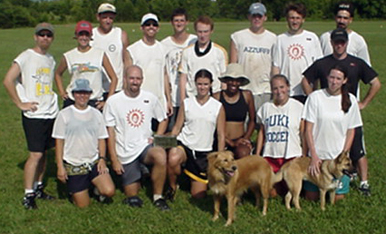
Spear, Knoxville, Tennessee.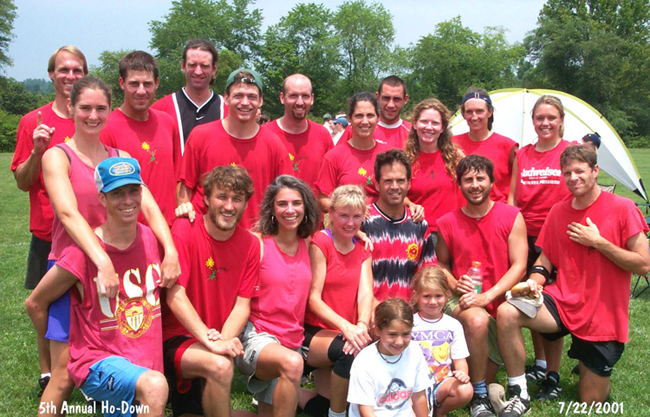
Spear, Brevard, North Carolina.- March 2001 | Rodning, Christopher B. (2001) Mortuary Ritual and Gender Ideology in Protohistoric Southwestern North Carolina. In Archaeological Studies of Gender in the Southeastern United States, edited by Jane M. Eastman and Christopher B. Rodning, pp. 77-100. University Press of Florida, Gainesville.
- March 2001 | Rodning, Christopher B., and Jane M. Eastman (2001) Introduction: Gender and the Archaeology of the Southeast. In Archaeological Studies of Gender in the Southeastern United States, edited by Jane M. Eastman and Christopher B. Rodning, pp. 1-9. University Press of Florida, Gainesville.
- Archaeological Field School at the Berry Site, Morganton, North Carolina, June 2001
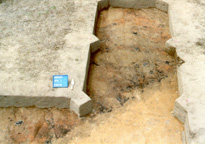
Structure 1 at the Berry site. Image source: Warren Wilson College, 2001.
2000
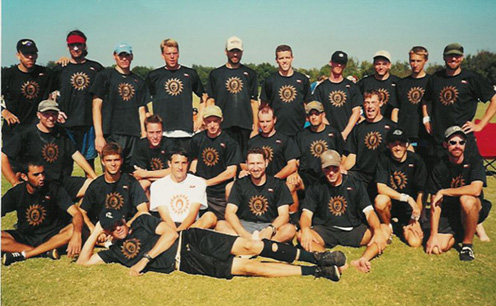
Ring of Fire, Sarasota, Florida.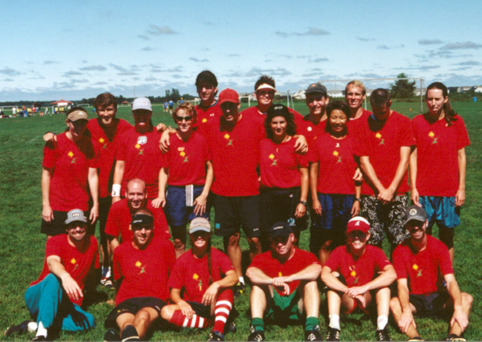
Spear, Blaine, Minnesota.
1996
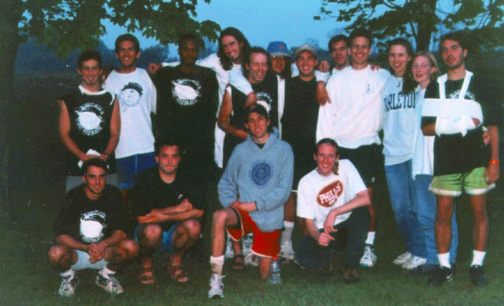
Darkside, Princeton, New Jersey.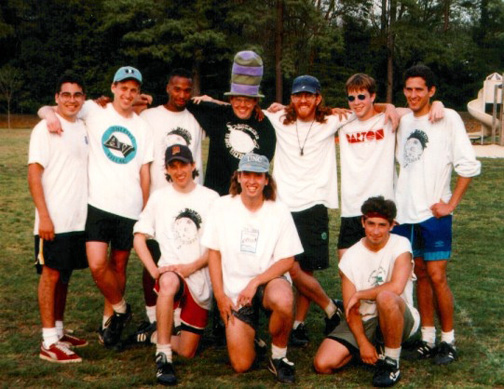
Darkside, Williamsburg, Virginia.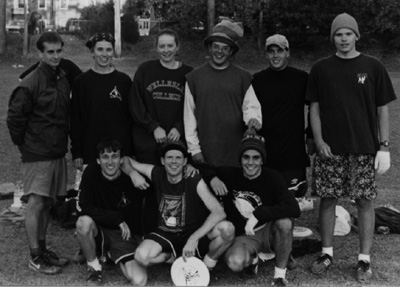
Darkside, Chapel Hill, North Carolina.
1994
1990
|
|

